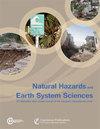Temporal clustering of precipitation for detection of potential landslides
IF 4.2
2区 地球科学
Q1 GEOSCIENCES, MULTIDISCIPLINARY
引用次数: 0
Abstract
Abstract. Landslides are complex phenomena that cause important impacts in vulnerable areas, including the destruction of infrastructure, environmental damage, and loss of life. The occurrence of landslide events is often triggered by rainfall episodes, single and intense ones or multiple ones occurring in sequence, i.e., clustered in time. Landslide prediction is typically obtained via process-based or empirical thresholds. Here, we develop a new approach that uses information on the temporal clustering of rainfall to detect landslide events and compare it with the use of classical empirical rainfall thresholds. In addition, we evaluate the performance of the two approaches combined together as a case study in the region of Lisbon in Portugal. We consider a dataset that categorizes landslides into shallow and deep events and a review of empirical rainfall thresholds that makes a good benchmark for testing our novel method. We show that the new approach based on temporal clustering overall has a good power of detecting landslide events but has a skill comparable with the classic rainfall threshold method. While there is no clear outperformance of one method, the novel clustering-based method has a higher sensitivity despite a lower precision than the threshold-based method. For all approaches, the potential detection is better for deep landslides than for shallow ones. The results of this study could help to improve the prediction of rainfall-triggered landslides.对降水进行时间聚类以探测潜在的山体滑坡
摘要山体滑坡是一种复杂的现象,会对脆弱地区造成重大影响,包括基础设施破坏、环境损害和生命损失。滑坡事件的发生通常是由降雨事件引发的,有单次强降雨事件,也有多次降雨事件依次发生,即在时间上聚集在一起。滑坡预测通常通过基于过程或经验的阈值来实现。在此,我们开发了一种新方法,利用降雨的时间聚类信息来检测滑坡事件,并将其与传统的经验降雨阈值进行比较。此外,我们还以葡萄牙里斯本地区为例,评估了这两种方法结合在一起的性能。我们考虑了将滑坡分为浅层和深层事件的数据集,以及经验降雨阈值的回顾,这为测试我们的新方法提供了一个很好的基准。我们的研究表明,基于时间聚类的新方法总体上具有良好的滑坡事件检测能力,但其技能与传统的降雨阈值方法不相上下。虽然没有一种方法明显优于其他方法,但基于聚类的新方法尽管精度低于基于阈值的方法,但灵敏度更高。对于所有方法而言,深层滑坡的潜在检测能力都优于浅层滑坡。这项研究的结果有助于改善降雨引发的滑坡的预测。
本文章由计算机程序翻译,如有差异,请以英文原文为准。
求助全文
约1分钟内获得全文
求助全文
来源期刊
CiteScore
7.60
自引率
6.50%
发文量
192
审稿时长
3.8 months
期刊介绍:
Natural Hazards and Earth System Sciences (NHESS) is an interdisciplinary and international journal dedicated to the public discussion and open-access publication of high-quality studies and original research on natural hazards and their consequences. Embracing a holistic Earth system science approach, NHESS serves a wide and diverse community of research scientists, practitioners, and decision makers concerned with detection of natural hazards, monitoring and modelling, vulnerability and risk assessment, and the design and implementation of mitigation and adaptation strategies, including economical, societal, and educational aspects.

 求助内容:
求助内容: 应助结果提醒方式:
应助结果提醒方式:


